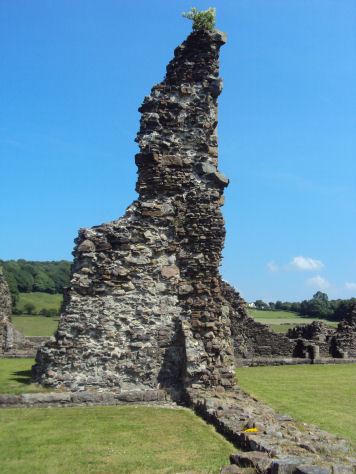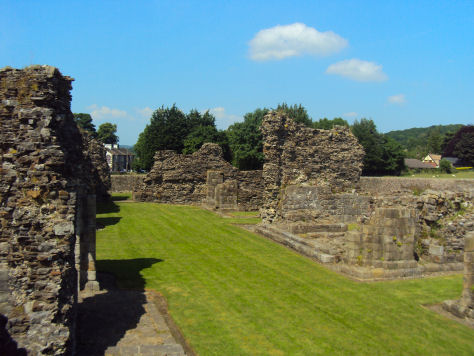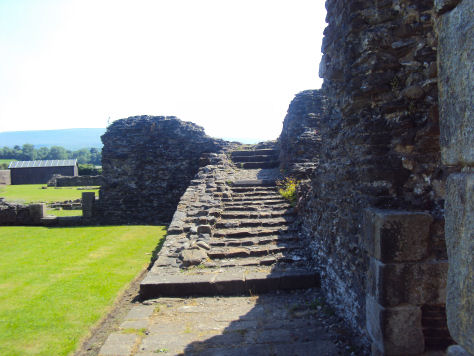Sawley Abbey
Grid Ref: -
The ruins of Sawley Abbey, or Salley Abbey, as it was known, are situated on the banks of the River Ribble, at the village of Sawley in Lancashire.


The Cistercian Abbey of Sawley was founded in 1147 by the Abbot Benedict, twelve monks and ten lay brothers from Newminster Abbey in Northumberland and dedicated to St Mary and St Andrew. Initially the abbey was housed in a timber building provided by William de Percy, the son of Alan Percy, in 1147-8, which was replaced in stone in the 1150s.
Sawley was never a large or wealthy abbey, and the monks struggled to farm in the wet and inhospitable climate and the marshy ground of the area around Pendle Hill. The Abbey buildings were still under construction when Maud de Percy, Countess of Warwick, William Percy's daughter, came to their aid and granted them St Mary's, Tadcaster, a chapel and pension in order to save them. The Percys, a powerful Northumberland family, remained patrons of the abbey for much of its existence.


The abbey was sited by an important north-south road and was obliged to provide hospitality and accommodation for travellers this incurred further expense. To add to the problems of the monks of Sawley, in 1296, Whalley Abbey was founded but nine miles from Sawley, causing competition over resources and the two Cistercian houses immediately quarrelled. Their lands were adjoining and they squabbled over grain supplies and fishing rights in the River Ribble. In the early fourteenth century the Scots raided the area and some of the Abbey buildings were burnt and cattle stolen.
Sawley Abbey was disolved in 1536, at the suppression there were 21 monks and 37 servants living at the abbey. Thomas Bolton was abbot of Sawley in 1536 when the Abbey was suppressed and he was succeeded by Abbot William Trafford, the son of an old Lancashire family, under whom several of the monks returned and took part in the ill fated Pilgrimage of Grace, which evoked a furious response from the implacable Henry VIII.
The Pilgrimage of Grace was a rebellion fired by discontent and ill feeling at hardship in the largely Catholic north caused by the dissolution of the monasteries. In October 1536 about 200 to 300 of the rebels led by Nicholas Tempest gathered at Whalley to persuade Abbot Paslew of Whalley Abbey to join the rebellion. They were later met by Thomas Stanley, Earl of Derby and dispersed. Stanley had promised immunity to those involved, however, Abbot Paslew and Abbot Trafford, along with two monks from Sawley and two local men, including Sir Stephen Hamerton, were subsequently arrested and executed for treason at on 10th March 1537 at Lancaster Castle.


Sawley Abbey was largely demolished and the stone sold, the land was purchased by Sir Arthur D'Arcy. During the following three centuries much of the stone stone was taken and reused in neighbouring farms and cottages, and many of the abbey buildings disappeared. In 1848 the first archaeological investigation of the ruins was undertaken and during the twentieth century the site was taken into the care of the state, cleared of debris and conserved.
Much of the what remains of the buildings to the present day are little more than foundations, with only some of the abbey church walls standing to any height. The remains demonstrate the usual layout with a church running east-west, forming the north range of the cloister. A well preserved part of the monk's night stairs to their dormitory can be seen in a corner of the south transept of the church. On the west side of the cloister stand the substantial ruin of the abbot’s lodgings, this building was converted to a cottage after 1537, and the great fireplaces and ovens date from this later period. Several patches of medieval mosaic tiling have also survived, and many of the carved corbels and other decorative stonework have been rescued during excavations. The sandstone arch was reconstructed from monastic fragments.
The Abbey is now in the care of English Heritage.
